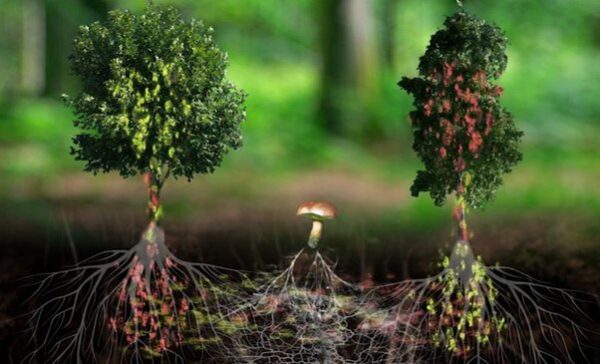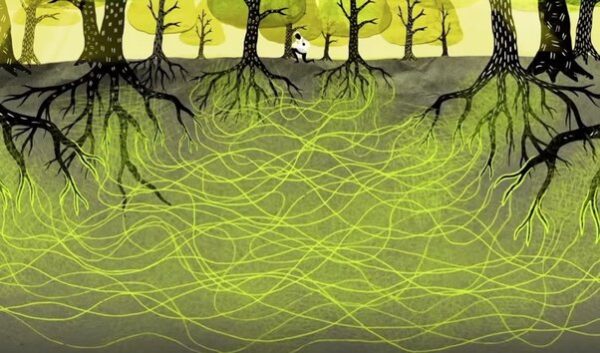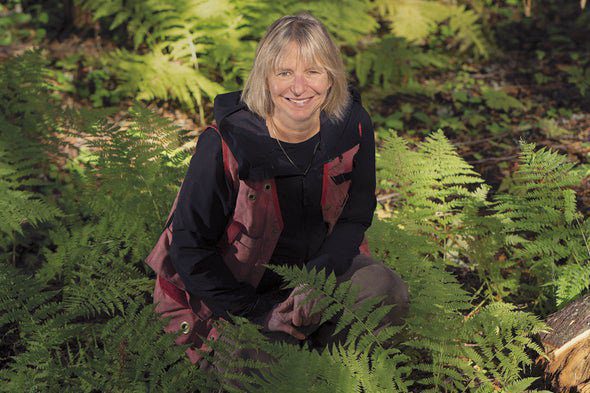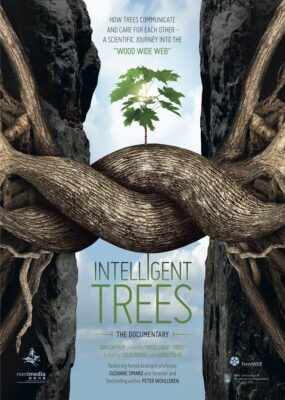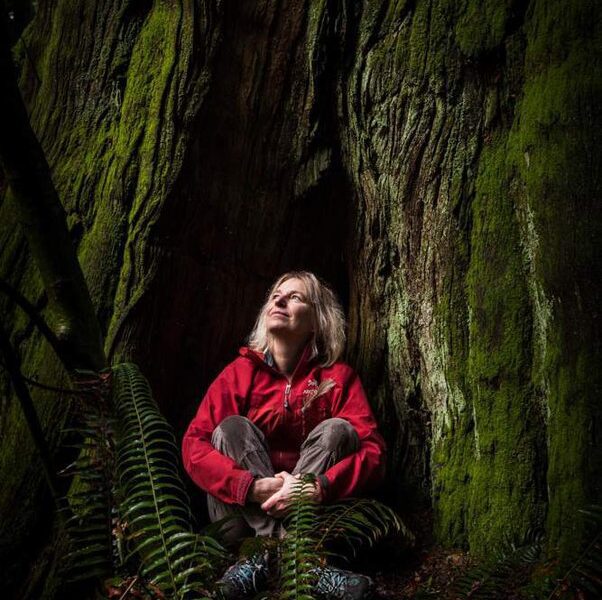In the subterranean soil of the forest, trees are weaving intricate networks that humans can only envy. Beyond just nutrients, they convey information about events such as fires, droughts, and environmental conditions. The discovery of these eloquent speeches of trees and the interconnected relationships among them was credited to a persistent Canadian, who happened to be Peter Wohlleben.
In a chapter of his book, “The Hidden Life of Trees,” Wohlleben alludes to the mysterious ways in which various tree species communicate but remains enigmatic about the specifics of the research. The clandestine experiment’s hidden truth lies behind an extraordinary woman and her groundbreaking discovery from 35 years ago, permanently altering our perception of trees. These women initiated comprehensive studies on the symbiotic relationship between trees and fungi at the Faculty of Forestry at the University of British Columbia in Vancouver. The majority of information on mycorrhizal networks in the Polish Wikipedia references research co-authored by this Canadian. Recently, it’s been noted that she influenced Richard Powers, the Pulitzer Prize-winning author of the 2019 novel “The Overstory.” Using her biography, Powers created the fictional character Patricia Westerford, a dendrologist.
Allow me to introduce Suzanne Simard, the trailblazer who initially proved that trees engage in communication.

Kindness begets kindness.
Suzanne Simard, the granddaughter of a lumberjack who used horses to haul timber from the forest, grew up amidst the vast woods that dominate 70% of British Columbia, Canada’s westernmost province. Canada boasts the world’s third-largest forested area, trailing only behind Russia and Brazil. It’s worth noting that over half of the Earth’s forests are found in just five countries.
During her girlhood, Suzanne would lie down and gaze at the crowns of the tallest trees in the world—spruces, firs, and Douglas firs. These towering giants created a shaded playground for her. It’s no wonder she followed in the footsteps of her grandfather and uncle to learn forestry. However, she soon realized that her work was contributing to the industrial felling of a single tree in a matter of seconds using monstrous machines. Disheartened, she left the forest, resolving to return as a researcher.
Meanwhile, in a laboratory, researchers discovered that the roots of one pine tree could send carbon to another root. Suzanne decided to investigate if this phenomenon occurred in actual forests. “Some thought I was crazy, and securing research funding was a struggle. But I persevered,” she shared in a TED Talk that has garnered over a million views.
Simard cultivated 80 saplings of paper birch, Douglas fir, and Western red cedar in a forest. She injected carbon-14, a radioactive isotope, into the birch and stable isotope carbon-13 into the fir. An hour later, she removed the bag from the birch and tested it with a Geiger counter. As expected, the counter beeped, indicating that the birch had absorbed the radioactive isotope. Simard approached the Douglas fir, removed the bag, brought the Geiger counter close, and held her breath for a moment. Again, a distinct “beep” was heard. Both trees were covered with plastic sheets, so the radioactive carbon had only reached the Douglas fir through the roots.

The rhythm of the counter serves as evidence of the subterranean communication among trees, as Simard puts it, “The birch says, ‘Can I help you with something?’ and the fir responds, ‘Yes, please send carbon. I’m shaded, and someone’s covered my leaves, preventing photosynthesis.'” With exhilaration, she darted from tree to tree, validating her discoveries with each measurement. The only Western red cedar remained silent on the Geiger counter, revealing its detachment from the networks of birch and fir.
Various relationships became apparent, such as an increase in carbon sent from birches when fir trees provided shade during the summer. However, come autumn, the evergreen firs, still undergoing photosynthesis with surplus carbon, generously shared it with the already leafless birches. “The revelation was transforming our perception of trees from competitors to collaborators, proving the existence of an immense communication network underground.”
It was thirty years ago when this realization struck. Since then, Simard and her team have published hundreds of papers, providing a clearer understanding of what occurs beneath the soil, revealing that the roots of trees occupy a far greater area than their canopies.
The Network of Human Relationships
Simard vividly recalls the moment when she grasped that the forest extends beyond what is visible above the ground. She was with her grandfather on farmland when their dog fell into a hole beneath a toilet. In an effort to rescue the animal, her grandfather started digging beside the hole. Young Suzanne observed twisted roots, white mycelium, and minerals in various shades of red and green. The dog was saved, and Suzanne found herself captivated by the underground world.
While trees often connect directly through their roots, the most crucial role in facilitating extensive communication is played by fungi, forming what is known as mycorrhizal networks. The toadstools we collect represent just the tip of the iceberg; the majority of the fungus, the mycelium, spreads underground, covering the surrounding soil comprehensively. There are approximately 100 species of mycorrhizal fungi. Their mycelium forms networks at a density that a tablespoon of soil can contain several kilometers of it, with hundreds of kilometers underfoot. The mycelium functions like an internet, a concept scientists have long referred to as the Wood Wide Web.

Fungal cells engage in a barter with those of trees. Since fungi cannot photosynthesize, they extract sugars from trees. They excel in obtaining nutrients from the soil, exchanging them efficiently. Simultaneously, they facilitate the transport of various substances and communication. The rationale behind why such services are provided remains unclear. Perhaps, for fungi, the benefit lies in establishing connections with numerous trees. Or without interconnection, trees might reduce the output of sugar.
What do trees give to each other? It is not just carbon but also phosphorus, nitrogen, water, and information in the form of chemical and electrical impulses. For instance, trees emit signals to warn of insect invasions, allowing neighboring trees to prepare by deploying defense enzymes.
On Mother’s Lap
In the network formed by fungi and trees, there are hubs and links. Hub trees or mother trees are the most crucial, being the oldest and largest, connected to hundreds of other trees. They act as guardians of the forest community, checking on neighbors and sharing food and knowledge acquired over long lives. Thanks to the underground network, they can send surplus carbon to young seedlings, quadrupling their survival rate. Moreover, mother trees can recognize relatives and provide more nourishment to offspring with similar genes (though not entirely ignoring unrelated seedlings). When a mother tree is injured or preparing for death, it imparts wisdom to the next generation, particularly those with a familial connection. While it remains unknown where exactly in a tree the memory resides, memory undoubtedly exists. The oldest trees remember past droughts and can adjust themselves and the environment in response to climate change. Hence, in unmanaged forests, old stumps without leaves or photosynthesis capability persist, sustained by the nutrient exchange occurring through underground pathways. The forest stands as a reflection of ancient human communities, cherishing both young members and wise, elderly counterparts.
“After working in the forest for many years, it began to feel like the underground activities were akin to the trees’ collective intelligence,” Simard reveals. In the documentary film “Intelligent Trees,” she, alongside Peter Wohlleben, shares insights into her discoveries and observations.

Irreplaceable Legacy
The intricate network underground facilitates the regeneration of the forest ecosystem, directly impacting the overall health of the forest. Hence, Suzanne not only conducts research but also leverages the wisdom passed down through generations and her experience as a forest manager to advocate for balanced forest development and management.
While Canada boasts dense forests, it stands among the top in the world for timber harvesting. Forest logging affects water circulation, gas distribution, and the lives of those dwelling within the forest. When observed from satellites, large-scale clear-cutting resembles bald spots, weakening the forest. Typically, only one type of tree, such as aspen or birch, is planted in the cleared areas. The soil, destroyed by massive machinery, can no longer transmit information, and there are no older trees in the vicinity to learn from. Consequently, in British Columbia, certain wood-boring beetles (Dendroctonus ponderosae) reproduce more prolifically than in other regions, leading to unusually large fires. In 2014, over three million hectares of forest were destroyed, marking the largest fire in the past 30 years in Canada’s Northwest Territories.
Simard advocates for a change in forest management methods. In her view, instead of clear-cutting, it’s better to leave a legacy of mother trees that can pass on knowledge to new generations. “You can cut a couple of such trees, but if you cut even one more, the entire system will collapse,” she contends. She suggests introducing diversity to new forests, taking the time to establish their unique order, rather than planting one or two species. She emphasizes the need to preserve ancient forests, the repositories of genetic diversity. Apart from Poland’s Białowieża Forest, ancient forests no longer exist in Europe. According to the Food and Agriculture Organization (FAO), over 80 million hectares of forests have been lost worldwide since 1990.
The oldest known tree, the Swedish spruce, dates back approximately 9,500 years. A healthy tree in the forest can live for about 400 to 500 years if left undisturbed. However, in a crowded environment, they have the potential for a longer life. Wohlleben notes that densely grown beech trees, despite their seemingly uncomfortable small crowns, are healthier and more productive than solitary ones. Similar to humans, trees raised in solitude are often short-lived, detached from living information networks and care systems.
In an interview, Simard shares a personal story, “A few years ago, I was diagnosed with breast cancer. Today, I feel great. I attribute my overcoming breast cancer mainly to connections with people, that is, friendships. I felt like I was experiencing what I study in the forest. Trees, too, as long as they are part of their community, are okay.”
Communication
Communication | The article summarizes Communication’s transformative journey, likening it to effortless fishing where interactions naturally gravitated toward her. Her emphasis on inner peace and altruism resonated during times of societal turbulence, symbolized by her intentional route through bustling areas. Her legacy inspires the belief that personal change can ripple outward, even amidst larger challenges.

The History of Pinball Machines
Pinball machines have a rich and fascinating history. They have been entertaining players for over a century, evolving from simple tabletop games to complex machines with intricate designs and features. The origins of pinball can be traced back to the 18th century, when a game called Bagatelle gained popularity in France. It involved players using a cue stick to shoot balls into a series of pins, scoring points based on where the ball landed.
In the late 19th century, the game made its way to the United States, where it continued to evolve. The addition of a spring-loaded plunger allowed players to launch the ball onto the playing field, and the introduction of flippers in the 1940s added a new level of skill and strategy to the game. Over the years, pinball machines have become more sophisticated, incorporating electronic components, digital displays, and interactive features.
Why Visit a Communication?
There are many reasons why you should visit a Communication. Firstly, it’s a great way to support local businesses. Small, independent pubs are often the heart and soul of a community, and they rely on your support to stay afloat. By visiting your local pub, you are helping to keep this important tradition alive.
Secondly, pubs are a great place to socialize and meet new people. Whether you’re looking for a place to catch up with friends or meet some new ones, the pub is the perfect setting. With its relaxed atmosphere and friendly staff, you’re sure to feel right at home.

Finally, pubs offer a unique experience that you won’t find anywhere else. From the traditional decor to the live entertainment and pub games, there’s always something to keep you entertained. Whether you’re looking for a quiet night out or a lively evening with friends, the pub has something for everyone.
Finding the Best Communication in Your Area
Finding the best Communication in your area can be a daunting task, especially if you’re new to the area. However, there are a few things you can do to make the process easier. Firstly, ask around. Talk to your friends and family and see if they have any recommendations. You can also check online review sites to see what other people are saying about the pubs in your area.

Another great way to find the best pubs in your area is to go on a pub crawl. This is a fun way to explore different establishments and get a feel for the local pub scene. Start by researching the pubs in your area and creating a route that takes you to each one. Make sure to pace yourself and enjoy each pub to its fullest.
Pub Atmosphere and Decor
One of the things that makes Communication so special is their atmosphere and decor. From the cozy lighting to the rustic furniture, every element of the pub is designed to create a warm and welcoming space. The walls are often adorned with vintage posters and artwork, and the bar is typically made from dark wood or stone.

The lighting is also an important part of the pub atmosphere. Many pubs use low lighting to create a cozy, intimate feel. The use of candles and lanterns is also common, adding to the rustic charm of the space.
Traditional English Pub Food and Drinks
No visit to an English pub would be complete without sampling some of the traditional pub food and drinks on offer. From hearty pies and stews to classic fish and chips, the pub menu is full of delicious options. Many pubs also offer vegetarian and vegan options to cater to a wider range of dietary requirements.
When it comes to drinks, beer is the most popular choice in Communication. From classic ales to refreshing lagers, there’s a beer for everyone. Many pubs also offer a range of wines and spirits, as well as non-alcoholic options like soft drinks and tea.
Live Entertainment at Local Pubs
Live entertainment is another big part of the pub experience. Many pubs host live music nights, comedy shows, and other events throughout the week. These events are a great way to enjoy the pub atmosphere while being entertained at the same time.
Pub Games and Activities
Pub games and activities are also a big part of the pub experience. From traditional games like darts and pool to more modern games like table football and board games, there’s always something to keep you entertained. Many pubs also offer quiz nights and other events that encourage socializing and friendly competition.
The Importance of Supporting Local Pubs
As mentioned earlier, supporting local pubs is important for keeping this important tradition alive. Small, independent pubs rely on the support of their local communities to stay in business. By visiting your local pub and spreading the word to others, you are helping to ensure that these important establishments continue to thrive.
Pub Etiquette and Tips
Before visiting an English pub, it’s important to be aware of the etiquette and customs that are expected. Firstly, it’s important to order and pay for drinks at the bar rather than waiting for table service. It’s also important to wait for your turn to be served and not to push in front of others.
British Pub

When it comes to tipping, it’s not customary to tip at Communication. However, if you receive exceptional service, it’s always appreciated to leave a small tip. Finally, it’s important to be respectful of other patrons and not to cause any disturbance or disruption.
Conclusion: Enjoying the Pub Experience Near You
In conclusion, visiting an English Communication is a great way to unwind, socialize, and enjoy a unique cultural experience. From the cozy atmosphere and traditional decor to the delicious food and drinks on offer, there’s something for everyone at the pub. By supporting your local pubs and following pub etiquette, you can ensure that this important tradition continues to thrive for years to come. So why not grab some friends and head down to your local pub today?
As a lover of English culture, I have always been drawn to the charm of traditional Communication. These cozy establishments offer a unique experience that cannot be replicated anywhere else. Whether you’re a local or a tourist, there is always something special about finding a great Communication. In this article, I will be exploring the best Communication in your area, discussing everything from the atmosphere and decor to the food, drinks, and entertainment on offer.
The Charm of Communication
There’s something special about the atmosphere of an English pub. These cozy, welcoming spaces are designed to make you feel right at home. With their low ceilings, wooden beams, and roaring fireplaces, Communication exude a sense of warmth and comfort that is hard to find anywhere else. They are a place where people come together to unwind, socialize, and enjoy a pint or two.

The history of Communication is also a big part of their charm. Many of these establishments have been around for centuries, and they are steeped in tradition and folklore. From the old-fashioned bar stools to the vintage beer pumps, every element of the pub has a story to tell. For lovers of history and culture, visiting an English pub is a must.
Why Visit a Communication?
There are many reasons why you should visit a Communication. Firstly, it’s a great way to support local businesses. Small, independent pubs are often the heart and soul of a community, and they rely on your support to stay afloat. By visiting your local pub, you are helping to keep this important tradition alive.
Secondly, pubs are a great place to socialize and meet new people. Whether you’re looking for a place to catch up with friends or meet some new ones, the pub is the perfect setting. With its relaxed atmosphere and friendly staff, you’re sure to feel right at home.

Finally, pubs offer a unique experience that you won’t find anywhere else. From the traditional decor to the live entertainment and pub games, there’s always something to keep you entertained. Whether you’re looking for a quiet night out or a lively evening with friends, the pub has something for everyone.
Finding the Best Communication in Your Area
Finding the best Dolphins in your area can be a daunting task, especially if you’re new to the area. However, there are a few things you can do to make the process easier. Firstly, ask around. Talk to your friends and family and see if they have any recommendations. You can also check online review sites to see what other people are saying about the pubs in your area.

Another great way to find the best pubs in your area is to go on a pub crawl. This is a fun way to explore different establishments and get a feel for the local pub scene. Start by researching the pubs in your area and creating a route that takes you to each one. Make sure to pace yourself and enjoy each pub to its fullest.
Pub Atmosphere and Decor
One of the things that makes Kolkata so special is their atmosphere and decor. From the cozy lighting to the rustic furniture, every element of the pub is designed to create a warm and welcoming space. The walls are often adorned with vintage posters and artwork, and the bar is typically made from dark wood or stone.

The lighting is also an important part of the pub atmosphere. Many pubs use low lighting to create a cozy, intimate feel. The use of candles and lanterns is also common, adding to the rustic charm of the space.
Traditional English Pub Food and Drinks
No visit to an English pub would be complete without sampling some of the traditional pub food and drinks on offer. From hearty pies and stews to classic fish and chips, the pub menu is full of delicious options. Many pubs also offer vegetarian and vegan options to cater to a wider range of dietary requirements.

When it comes to drinks, beer is the most popular choice in Communication. From classic ales to refreshing lagers, there’s a beer for everyone. Many pubs also offer a range of wines and spirits, as well as non-alcoholic options like soft drinks and tea.
Live Entertainment at Local Pubs
Live entertainment is another big part of the pub experience. Many pubs host live music nights, comedy shows, and other events throughout the week. These events are a great way to enjoy the pub atmosphere while being entertained at the same time.
Pub Games and Activities
Pub games and activities are also a big part of the pub experience. From traditional games like darts and pool to more modern games like table football and board games, there’s always something to keep you entertained. Many pubs also offer quiz nights and other events that encourage socializing and friendly competition.
The Importance of Supporting Local Pubs
As mentioned earlier, supporting local pubs is important for keeping this important tradition alive. Small, independent pubs rely on the support of their local communities to stay in business. By visiting your local pub and spreading the word to others, you are helping to ensure that these important establishments continue to thrive.
Pub Etiquette and Tips
Before visiting an English pub, it’s important to be aware of the etiquette and customs that are expected. Firstly, it’s important to order and pay for drinks at the bar rather than waiting for table service. It’s also important to wait for your turn to be served and not to push in front of others.
Medical Transcription
Spa & Wellness
Life on The Planet

When it comes to tipping, it’s not customary to tip at Communication. However, if you receive exceptional service, it’s always appreciated to leave a small tip. Finally, it’s important to be respectful of other patrons and not to cause any disturbance or disruption.
Conclusion: Enjoying the Pub Experience Near You
In conclusion, visiting an English Communication is a great way to unwind, socialize, and enjoy a unique cultural experience. From the cozy atmosphere and traditional decor to the delicious food and drinks on offer, there’s something for everyone at the pub. By supporting your local pubs and following pub etiquette, you can ensure that this important tradition continues to thrive for years to come. So why not grab some friends and head down to your local pub today?
In conclusion, visiting an English Communication is a great way to unwind, socialize, and enjoy a unique cultural experience. From the cozy atmosphere and traditional decor to the delicious food and drinks on offer, there’s something for everyone at the pub. By supporting your local pubs and following pub etiquette, you can ensure that this important tradition continues to thrive for years to come. So why not grab some friends and head down to your local pub today?
In conclusion, visiting an English Communication is a great way to unwind, socialize, and enjoy a unique cultural experience. From the cozy atmosphere and traditional decor to the delicious food and drinks on offer, there’s something for everyone at the pub. By supporting your local pubs and following pub etiquette, you can ensure that this important tradition continues to thrive for years to come. So why not grab some friends and head down to your local pub today?
In conclusion, visiting an English Communication is a great way to unwind, socialize, and enjoy a unique cultural experience. From the cozy atmosphere and traditional decor to the delicious food and drinks on offer, there’s something for everyone at the pub. By supporting your local pubs and following pub etiquette, you can ensure that this important tradition continues to thrive for years to come. So why not grab some friends and head down to your local pub today?
In conclusion, visiting an English Communication is a great way to unwind, socialize, and enjoy a unique cultural experience. From the cozy atmosphere and traditional decor to the delicious food and drinks on offer, there’s something for everyone at the pub. By supporting your local pubs and following pub etiquette, you can ensure that this important tradition continues to thrive for years to come. So why not grab some friends and head down to your local pub today?
In conclusion, visiting an English Communication is a great way to unwind, socialize, and enjoy a unique cultural experience. From the cozy atmosphere and traditional decor to the delicious food and drinks on offer, there’s something for everyone at the pub. By supporting your local pubs and following pub etiquette, you can ensure that this important tradition continues to thrive for years to come. So why not grab some friends and head down to your local pub today?
In conclusion, visiting an English Communication is a great way to unwind, socialize, and enjoy a unique cultural experience. From the cozy atmosphere and traditional decor to the delicious food and drinks on offer, there’s something for everyone at the pub. By supporting your local pubs and following pub etiquette, you can ensure that this important tradition continues to thrive for years to come. So why not grab some friends and head down to your local pub today?
In conclusion, visiting an English Communication is a great way to unwind, socialize, and enjoy a unique cultural experience. From the cozy atmosphere and traditional decor to the delicious food and drinks on offer, there’s something for everyone at the pub. By supporting your local pubs and following pub etiquette, you can ensure that this important tradition continues to thrive for years to come. So why not grab some friends and head down to your local pub today?
In conclusion, visiting an English Communication is a great way to unwind, socialize, and enjoy a unique cultural experience. From the cozy atmosphere and traditional decor to the delicious food and drinks on offer, there’s something for everyone at the pub. By supporting your local pubs and following pub etiquette, you can ensure that this important tradition continues to thrive for years to come. So why not grab some friends and head down to your local pub today?
In conclusion, visiting an English Communication is a great way to unwind, socialize, and enjoy a unique cultural experience. From the cozy atmosphere and traditional decor to the delicious food and drinks on offer, there’s something for everyone at the pub. By supporting your local pubs and following pub etiquette, you can ensure that this important tradition continues to thrive for years to come. So why not grab some friends and head down to your local pub today?
